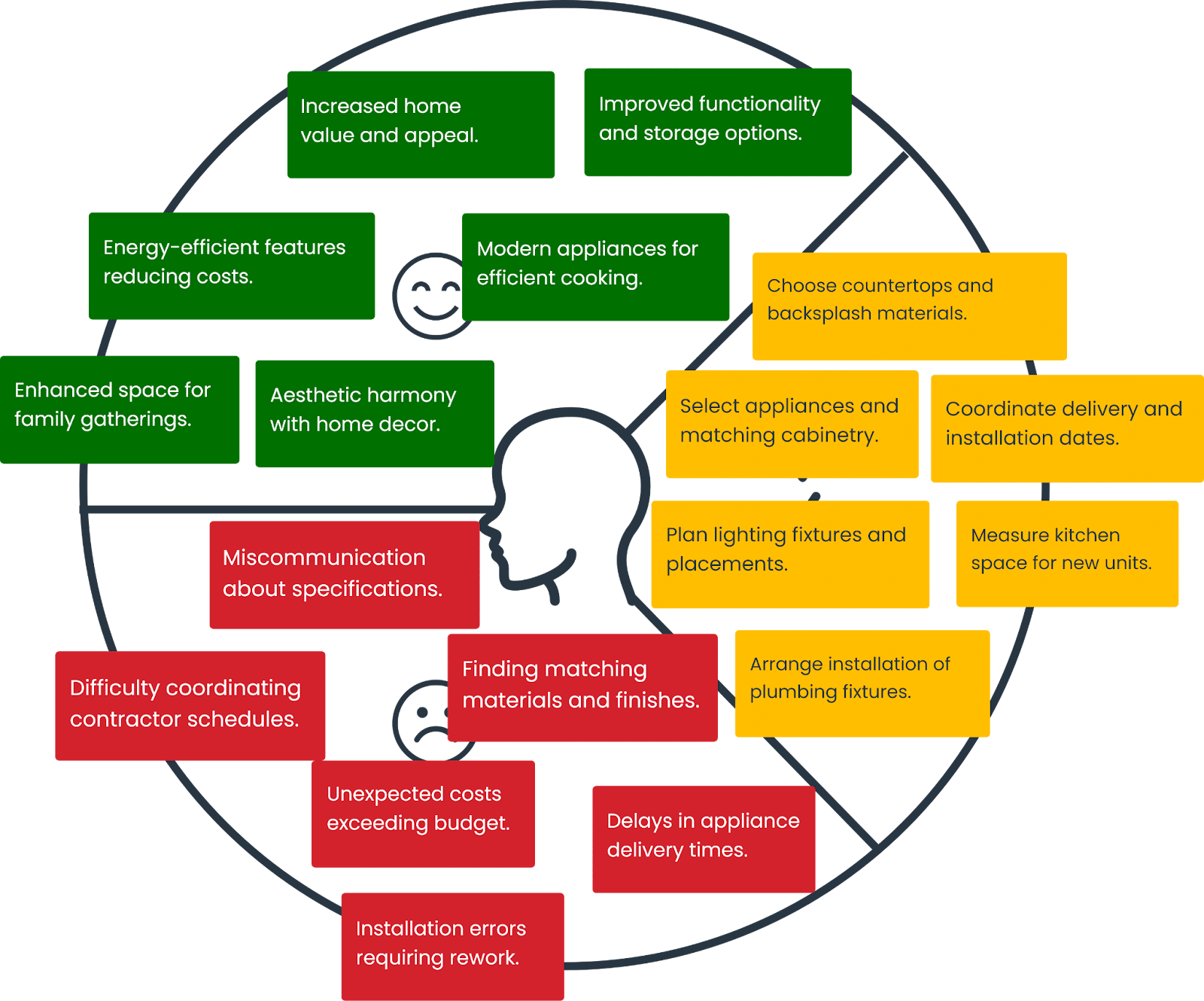
The Value Proposition Canvas is a tool designed to help businesses create value for their customers.
Typically, this relates to products or services. However, I have found the framework incredibly useful for content ideation, with customer fit and value at the heart of the process (as it should be).
To help you put this into practice, take a copy of this templated worksheet and use it each time you need to generate some more ideas.
Clarifying your SEO approach
This article continues my recent series on SEO strategies, SEO planning, using generative AI to help with SEO and how to create helpful, people-first content. Reading those first (or later) would help, but it is in no way essential.
The idea I am pushing here is that most of the talk and content around SEO strategy is not actually about strategy but is focused on tactics and planning.
Strategy and planning are not the same thing.
- Strategies are the long-term ideas and goals.
- Tactics are the short-term moves you make to gain an advantage.
The combined goal of these articles is to give you a clear path from strategy to tactics and help you document that path in a simple plan.
Why write content for Google in 2024?
Despite the popularity of social media, the buzz around AI and some game-changing algorithm updates, Google is still the primary source of website traffic.
Google sends up to 70% of all referral traffic while everyone else picks up (or gives out) the scraps.
For context, Facebook, the highest traffic source social network, sends about 3% of traffic, so it is small beans compared to Google.
The long and short is that Google is still the biggest driver of website traffic and by a good measure.
Introduction the Value Proposition Canvas (VPC)
The Value Proposition Canvas (VPC) was developed by Dr. Alexander Osterwalder to help businesses create a strong fit between products and the marketplace.
The framework is designed to help businesses create successful products and services by focusing on the customer’s needs. It’s covered extensively in Strategyzer’s book “The Value Proposition Design.”
The general idea is that:
- Businesses design new products and services every day
- The majority of these fail miserably
- Focusing on what matters to the customer helps you succeed
The Value Proposition Canvas helps fix this for products and services by ensuring they are created to address customer goals, pains and jobs. The canvas then helps you get “fit” between your products and services and what your customer really needs.
The canvas has two main areas, each divided into three sections.
- Value proposition
- Products and services
- Gain creators
- Pain reliever
- Customer segment
- Gains
- Customer jobs
- Pains

This is a simple visual tool to help you work through the customer, detailing jobs, pains and desired gains on the right-hand side (customer segment).
Then, you fill out your value map by mapping products and services to the customer jobs and detailing how these relieve pains and create gains for the customer.
Using the Value Proposition Canvas for content ideation and SEO
As SEOs and content marketers, we can leverage this approach in the age of helpful, people-first content as we seek to map value-based solutions to prospective customers’ searches.
As with much marketing, the magic is in the process. There is little here that you probably don’t already know on some level, but the process helps to bring all this hidden knowledge to the surface and articulate it in a way that supports content ideation.
Simply put, the Value Proposition Canvas approach forces us to imagine our customer segments’ mindsets and rationally think things through.
Follow these steps to generate high-value content ideas for your customers’ needs and wants.
Step 1: Become the customer
Download the template and walk through these steps:
Customer segment
Identify a customer segment that you want to profile. This can’t be just anyone or everyone; you must narrow it down to talk to a specific segment, so please don’t skip this.
List customer jobs
Customer jobs are the functional, social and emotional tasks customers are trying to perform, problems they are trying to solve and needs they wish to satisfy.
Examples:
- Functional jobs: Mow the lawn, eat healthy, write a report.
- Social jobs: Dress well, make social media posts, publish blog posts.
- Personal jobs: Enjoying life, personal growth, feeling secure, safety.
List customer pains
Pains are aspects of customer jobs that make the customer’s life difficult. These can include time spent, technical issues, or not getting the right results.
Examples:
- Undesired outcomes: Something annoying, dull, or does not work.
- Obstacles: Anything that gets in the way of success (time, money, etc.).
- Risks: Things that may go wrong like fines, non-compliance, issues, etc.
Note: The template includes questions to help identify customer pains.
List customer gains
Gains should describe the outcomes and benefits you are looking for with your content.
Gains can be focused on business, reputation, utility, social or whatever is most relevant for your customer.
Examples:
- Required gains: Leads, sales, profit, customers, etc.
- Expected gains: Traffic, exposure, Google rankings, customer attention.
- Desired gains.
- Unexpected gains: Viral potential.
Note: The template includes questions to help identify customer pains.
Example: New kitchen customer
In this example, we have filled out the customer’s jobs (yellow), pains (red) and gains (green).
- Customer segment: Homeowners looking to refurb their kitchens. They have a limited budget and are unsure how to do this without breaking the bank.

Step 2: Ranking jobs, pains and gains
Once you have your list of jobs, pains and gains, another essential step is to organize things by priority and opportunity.
- Job importance: Rank jobs by the most important to the customer.
- Pain severity: Rank pains by how extreme and problematic they are.
- Gain relevance: Rank gains by how essential they are in the customer’s eyes.
This helps you prioritize content development efforts and ensures that any content created speaks the customer’s language.

Step 3: Value-driven content plan
By following this process, you get into your customers’ mindset and now clearly understand your target customers’ objectives, problems and desired outcomes (gains, pains and jobs).
You can now start filling out the template’s value side with content ideas.
Content ideas
Here, we replace products and services from the standard Value Proposition Canvas and replace it with content ideas.
The content ideas will be mapped to the jobs, pains and gains.
- Content to help with customer jobs
- Create tutorials, step-by-step guides, or comprehensive reviews. These help your audience tick jobs off their list.
- For instance, “How to change your kitchen cupboard doors” could help a customer looking to refresh their kitchen but does not have a huge budget!
- Generally, this will be product – and service-oriented and the content closest to purchase.
- Content to alleviate pains
- Your content should address the challenges that the audience faces.
- For example, if the audience wants to change their kitchen doors but is unsure how to fit them, create guides showing how to measure, detach and install the new doors.
- Content to amplify gains
- We seek to create content ideas that map to your customers’ goals.
- This could be case studies of previous kitchen renovations, style guides, or the latest appliances.
Populate your ideas in the SEO Content Value Proposition template.
Formats
When thinking about your content, remember that modern SERPs are varied and will often feature articles, videos, page features and much more.

Content and conversion fit
Our goal here is to create value for the customer with our content.
We do that by understanding the customer and creating content that helps them achieve their goals.
Simple example
It is useful to simplify this as much as possible so you can clearly understand and articulate it to people in your team.
For a business selling kitchens to budget-conscious customers:
- Customer jobs: Setting up a functional kitchen within a tight budget.
- Pains: High costs of kitchen units, complexity of installation and high energy consumption.
- Gains: Affordable pricing, easy installation and long-term cost savings.
You then map content ideas to this improved understanding of your customer.
Some value-based content ideas include:
- Product and service content:
- Benefits of modular kitchen units.
- Save money with DIY kitchen installation kits.
- The best energy-efficient appliances.
- Pain relievers:
- What is the best way to finance a kitchen?
- Learn from the pros with a free kitchen consultation.
- Gain creators:
- Understanding kitchen guarantees.
- The most popular layouts for modern kitchens.
- Space-saving solutions for small kitchens.
There is nothing complicated here. Rather, this is just a framework for thinking about content ideas from the perspective of your ideal customer segments so you can focus on their needs and deliver maximum value.
Common mistakes and problems
Remember, this is an ideation process. By its very nature, it is a creative endeavor, so it works best in a team setting. That said, if you are a lone gun, you can easily integrate AI tools into your SEO content planning to act as your assistant.
Common problems we see include:
- Too broad a customer profile. Get specific!
- Remember to include social and emotional jobs. We buy with emotions, not logic.
- Not going into enough detail about your jobs, pains and gains.
- Not connecting the dots between jobs, pains and gains.
- Specifying content ideas just as the opposite of vague jobs, pains or gains.
Generate SEO content ideas that resonate with your audience
With SEO difficulties and costs spiraling, focusing on customer value to maximize returns from content marketing efforts is crucial.
To get results from SEO in 2024, all the planets must be aligned. Your website SEO has to be perfect, your content has to be aimed squarely at your customer’s needs, and you must measure your SEO results carefully.
The Value Proposition Canvas brings structure to the often chaotic and unpredictable task of generating content ideas. Done well, this will help you get in front of your prospective customers as they research their problems.
Hopefully, this process helps you start with a solid foundation of content ideas that truly help, support and resonate with your target audience.
from Search Engine Land https://ift.tt/asl8VjQ
via IFTTT
No comments:
Post a Comment